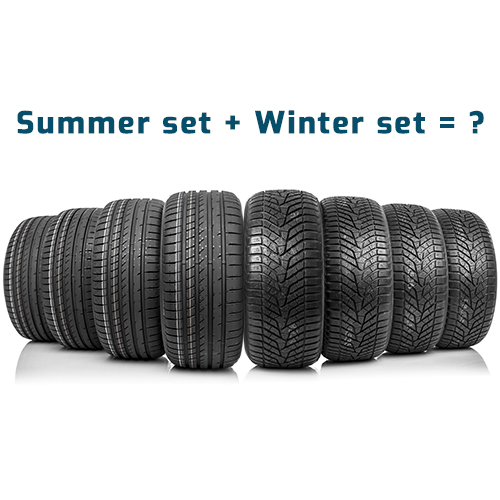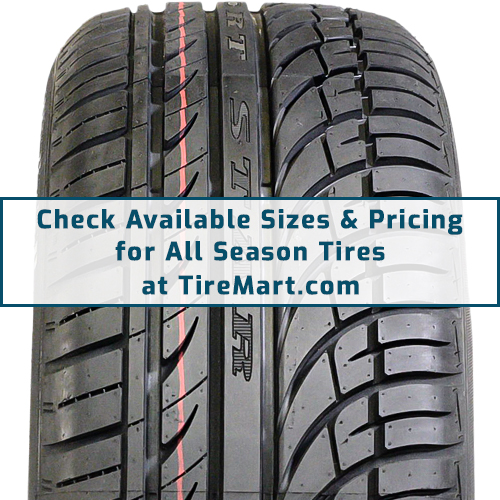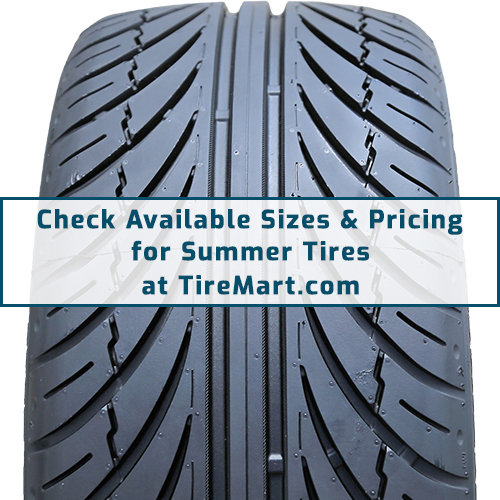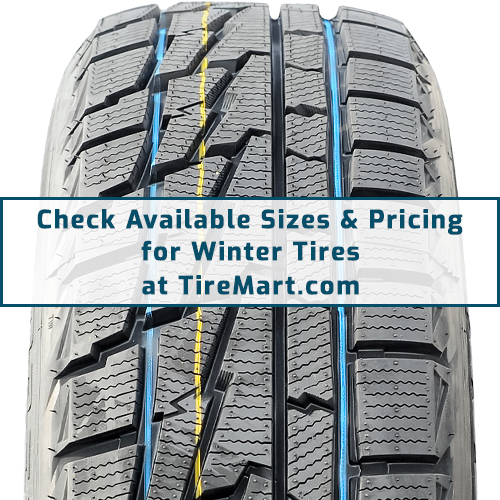The age-old question is: Can we just purchase 1 set of all season tires and use them all year round?
The answer might be a bit more complicated than we would like. It all depends…
Depends on what weather conditions we will be driving in, if we have severe weather changes throughout the year, etc. So, how can we actually answer this question?
We need to take a step back and actually talk about the pros and cons of all season tires, without neglecting to mention what summer and winter tires offer.
All Season Tires
The Goodyear Tire Company manufactured the first all season tire set in 1977. These tires fulfilled the needs consumers have created.
Constantly changing summer tires to winter ones, and then snow tires to summer ones can become annoying. Many drivers do not wish to deal with this, and tire manufacturers have jumped on the idea of creating year round tires.
But, are these all season tires really safe to use?
Well, the answer is yes. All season tires are safe to use, but they do not offer the best traction in certain conditions.
Let’s take a look at what we mean by that!
Pros of All Season Tires
All season tires are made to be used throughout the year, in both warm and cold weather conditions. Due to this, they are manufactured with durable rubber compounds, which remain flexible even in freezing temperatures. This means that different temperatures will not ruin the tire’s performing safety as the seasons change.
Additionally, these tires also come with ideal tread patterns, which provide sufficient traction and biting edges. As a result, the tire is able to conquer icy conditions and winter roads, if the driver is careful.
So, the tread compound and the tread are both capable of offering some traction in summer and winter driving conditions. But, will this be enough to ensure the vehicle’s utmost driving safety?
No.
Cons of All Season Tires
Just because the tire is able to provide good traction in wet conditions, on dry pavement, and on icy roads, does not mean it is completely safe to use.
The rubber compound keeps the tire flexible and avoids heat build-up. Yet, they still don’t offer the same safety and traction levels as summer and winter tires offer. These tires perform well, but they do not provide the same safety.
Furthermore, their specially designed tread pattern with more sipes will never offer security in true winter conditions. When ice and snow cover the road surface, and the grooves have to channel snow and slush away, all season tires will fail.
They still might grip the road, but most drivers with experience will agree – they are not as safe as snow tires. The difference between all season tires and other seasonal tires is obvious.
The Verdict on All Season Tires
All season tires are a good choice if you live in mild conditions. Areas, where no true summer or winter are experienced, are perfect for all weather tires.
They will improve traction in such temperatures, optimizing the surface grip. They ensure the tire’s forward motion and the stopping distance of the car. While they do not offer the needed ice and snow grip, they are still able to perform in cold temperatures and in light snow.
So, if you wish to keep your all season tires mounted all year round, be sure you know what to expect. Careful driving is essential to guarantee your safety if you live in areas with harsher weather changes. You do not wish to slide about or end up in a ditch.
Still, sacrificing your driving security might not be the best way to save money.
Summer Tires
A good summer tire set is essential in warmer temperatures. These tires utilize the minimalistic tread pattern and heat-resistant rubber compounds to enhance the dry and wet weather performance.
They guarantee better traction even on wet roads, but they are not for winter weather use.
Summer tires provide the best high speed durability and controllability. Additionally, summer tires are able to combat the rain. While they offer hydroplaning resistance, their main focus is keeping the drivers’ control over the vehicle at all times.
When do I Need to Mount Summer Tires?
When temperatures reach approximately 50 degrees Fahrenheit, summer tires should be placed on the vehicle.
In such weather conditions, snow tires are no longer safe for use. Their compound and tread pattern are not for warm weather applications, which can ruin their tread life.
In order to ensure a secure performance, without the use of an all weather tire set, summer tires have to be mounted on the vehicle. Their durable compound is able to provide a longer tread life, while the road contact optimizes its handling capability.
Winter Tires
So, what’s the deal with winter tires? Why are they so important and why can’t all weather tires replace them?
The answer is simple. Their durable winter compound and ideally detailed tread pattern provide ice and snow traction.
They feature high-density siping patterns which offer additional biting edges. This, along with the wider groove placement, enables winter tire sets to easily conquer deep snow winter conditions as well. This optimized snow traction guaranteed the tire’s constant forward motion.
On the other hand, it handles cold temperatures well as well. Winter or snow tires are made from durable compounds which keep their flexibility in freezing conditions as well. This further upgrades the tires’ winter performance.
A winter tire must also prevent hydroplaning. In the winter months, especially when the snow starts melting, water and slush cover the roads. Winter tires have to channel them away from their footprint to ensure their constant surface contact.
When do I Need to Mount Snow Tires?
Mounting winter tires on your vehicle is a good idea when the temperature reaches 45 degrees Fahrenheit. This magic number is when all season and summer tires no longer perform at their best caliber.
When winter months arrive, winter tires need to be put on the vehicle to guarantee their safe performance. These tire sets are able to ensure the car or vehicle performs in the desired manner, even on ice or snow.
Additionally, the footprint’s siping detail provides the same amount of biting edges no matter which condition the tire is used in. The compound elements keep their flexibility even in freezing temperatures. This combination makes winter tires perfect for ice and snow traction.
Another question worth looking at is this. Do you need to change the tire pressure sensors when you change the tire sets? Read our blog post about replacing TPMS system and learn more!
Do You Really Need Two Sets of Tires?
As mentioned before, all season tire sets are considered safe. However, being “safe” does not necessarily mean the tires will keep the vehicle on the road.
You need to assess your surroundings. If your area experiences harsh winter conditions each year, you will need to invest in a set of winter tires. Check out how much winter tires cost at TireMart!
On the other hand, if you wish to use off season tires in various conditions, you need to know the risks. Using tires in weather conditions they are not intended for will cause them to lose the manufacturers’ warranty. They will also not perform in a necessary manner to guarantee their traction.

Does It Cost More Money to Use Two Sets of Tires?
Investing in two sets of tires, and their yearly mounting and balancing will increase the cost of the vehicle’s upkeep. Yet, it pays out in the end.
But using summer and winter tires in their indented weather conditions you are lengthening their service life. Soft winter compounds wear more quickly in summer, while summer tires are dangerous in winter.
If you keep changing the tires, twice a year, you are doing more than most drivers to ensure the tire’s performing safety. By switching to summer tires in warmed conditions, you are making sure your winter tire set will not have accelerated wear.
Additionally, by getting a second set of wheels, you can also cut down on the mounting and balancing costs. While purchasing an extra four wheels for your vehicle might seem like a stretch, some drivers swear by it.





